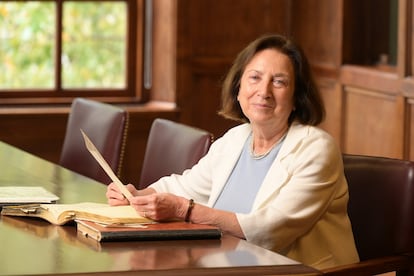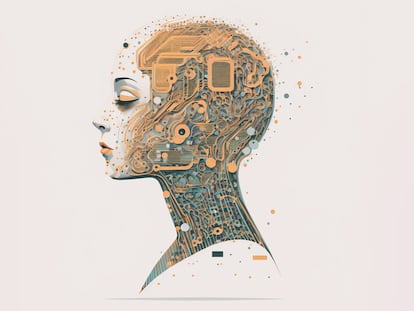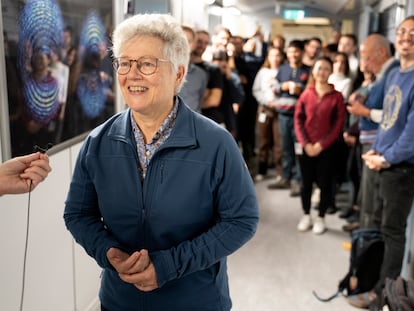For the first time, the journal ‘Nature’ has chosen a non-human being — ChatGPT — as one of its scientists of the year
The prestigious scientific publication highlights the chatbot alongside one of its creators, a forgotten pioneer of weight loss drugs and the scientist behind a historic breakthrough against cancer

Each December, the journal Nature chooses ten people who figured prominently in some of the year’s most relevant science stories. On the 2023 list published today, the journal included a non-human entity for the first time. ChatGPT, a robot capable of answering questions and holding conversations in a more or less intelligent way, has helped write academic papers, summarized scientific articles and prepared documents that have been used to apply for research grants. It has also intensified the debate about the limits of artificial intelligence, the nature of human intelligence and how these new technologies should be regulated.
Along with this technology’s potential for managing and even creating new knowledge, the editors of Nature point out the need for transparency in using such a powerful tool. They warn that “the size and complexity of LLMs [large language models, on which programs like ChatGPT are based] means that they are intrinsically ‘black boxes’, but understanding why they produce what they do is harder when their code and training materials aren’t public, as in ChatGPT’s case.” Although we do not know what these models will yield and what the limits of computational capacity and available databases will be, the generative artificial intelligence revolution is unstoppable.
The human brain behind artificial intelligence
Although a machine is recognized as one of the scientists of the year, Nature’s list also includes one of its creators. Ilya Sutskever, the chief scientist and cofounder of OpenAI, the organization that created ChatGPT, is one of the minds at the forefront of generative artificial intelligence. He saw this company, showered with billions of dollars by Microsoft, as an opportunity to develop general artificial intelligence that could outperform humans and develop its own consciousness. In recent months, he devoted his efforts toward creating a method to direct and control artificial intelligence systems that are more intelligent than humans.
Sutskever believes that artificial intelligence’s potential is too great for models to be available to anyone who wants to use them, and he was among the first to realize that the systems that scientists like his mentor, Geoffrey Hinton, had begun to develop would begin to show their actual capabilities as computing power increased. A month ago, he was swept up in a whirlwind of human passions in the company he founded. As a member of OpenAI’s board of directors, he ousted its CEO, Sam Altman, for loss of confidence. Three days later, he tweeted that he regretted this decision. Two months earlier, he had warned that anyone who valued intelligence above all other human qualities would have “a bad time.”
Mice born from the cells of two males
In March, Katsuhiko Hayashi of Osaka University announced that he had created mouse offspring from the cells of two males. In 2016, Hayashi and his team had already succeeded in creating functional mouse eggs from stem cells. This time, they took cells from the tails of male mice, with their X and Y chromosomes, and converted them into stem cells. In the process, 3% lost their Y chromosomes, and were selected by the researchers, who then treated them to cause errors during cell division. Some of these errors produced cells with two X chromosomes, as in female cells, and the scientists continued the process to convert these stem cells into oocytes. Many cells were lost in each step of this painstaking work. In the end, they were able to create 630 embryos for implantation in female mice. Seven offspring were born from these embryos. The researchers believe that applying these techniques to humans, whose cells are more difficult to work with, is still a long way off, but they want to apply them to save the northern white rhinoceros (Ceratotherium simum cottoni), a species that has only two females left.
The forgotten pioneer of weight loss pills

One of the year’s important scientific news stories has been the widespread use of GLP-1 analogs for obesity. Originally developed to treat diabetes, these drugs mimic the hormones that naturally make us feel full after eating. Their effectiveness in weight loss has made them a bestseller. Nature journal reminds us that this product was possible for the first time, in part, thanks to the pioneering work of Svetlana Mojsov, a researcher at Rockefeller University in New York, who identified and characterized the hormone and created the peptides and antibodies, enabling the experiments that showed that GLP-1 could reduce blood glucose levels. Despite the success of drugs like semaglutide, which have sales of about $1 billion a month, Mojsov has long been ignored. After years of struggle, the researcher has managed to get journals such as Cell and Nature to make changes in their publications and include her work with these molecules when she was at Massachusetts General Hospital in Boston.
Progress against malaria
The major players in global science are usually concentrated in rich countries, where the resources exist to pay for brains and equipment. This year’s list includes Halidou Tinto, the director of the Nanoro Clinical Research Unit in Burkina Faso, who enters from a place where, until his arrival in 2007, there was no electricity. This year, thanks to his work in clinical trials, the World Health Organization recommended the R21 malaria vaccine. It is the second vaccine against this disease, which causes half a million deaths a year in Africa; most of the fatalities are children under five years of age. The institute that Tinto leads has been a key testing site for these vaccines, and the researcher is working on over 30 clinical trials for diseases that primarily affect poor countries.
Fighting for the environment
Nature celebrates Marina Silva’s return to the Brazilian government. In August, Brazil’s Minister of Environment and Climate Change announced a 43% decrease in deforestation alerts in the Amazon rainforest this year as compared to the previous year. During Jair Bolsonaro’s presidency, the magazine notes, “the government issued 40% fewer fines for environmental crimes and logging in the Amazon increased by about 60%.
The second environmental champion is Eleni Myrivili, the first U.N. Global Chief Heat Officer. After years of raising awareness about global warming’s effects on citizens’ lives as a city councilor in Athens, she has now moved on to develop that work on a global level. She also seeks funding to make cities more sustainable and resilient to rising temperatures. At the Dubai climate summit, she sought support for cooling technologies that do not produce greenhouse emissions.
Progress against bladder cancer
Progress against some tumors has not followed the overall positive trend in the fight against cancer. This year, Thomas Powles of St. Bartholomew’s Hospital in London saw results that he thought were incredible. A two-drug combination, a kind of Trojan horse involving a targeted drug that delivers a chemotherapy payload to the desired site, increased the median survival rate of bladder cancer patients from 16 months to two and a half years. Powles, another of Nature’s scientists of the year, says this milestone is the biggest for advanced bladder cancer in the last four decades and the only one that can improve on the standard treatment, which has been used since the 1980s.
Harnessing the sun’s energy
One hope for achieving abundant energy without harming the environment is controlling nuclear fusion, the phenomenon that illuminates the sun. Last summer, U.S. scientists at a $3.5-billion-laser facility at the Lawrence Livermore National Laboratory in California succeeded in compressing hydrogen nuclei into helium nuclei to produce more energy than is needed to produce such fusion. Annie Kritcher, an engineer at the National Ignition Facility, played a key role in this achievement by creating the capsule that traps the atoms on which laser beams are directed to initiate the nuclear reaction. Kritcher believes it will be possible to increase the energy produced to the levels necessary for creating the first prototype laser nuclear fusion reactor.
Correcting superconductivity articles published in ‘Nature’
When properly applied, science has the ability to correct its own mistakes. That is what stands out in the case of James Hamlin, a physicist at the University of Florida in Gainesville, who detected problems in scientific articles that claimed to have found a superconductor of electricity at room temperature. Now retracted, the articles were written by physicist Ranga Dias, who spoke of a “holy grail” that could change the world as we know it” when he was named on Nature’s 2020 list of ten outstanding scientists. This material would make it possible to design ultra-efficient engines and transport networks without energy losses, but it seems that the dream will have to wait.
A prize for coming in fourth
When Chandrayaan-3 successfully landed on the moon, India became the fourth country after the U.S., the Soviet Union and China to achieve that feat. Kalpana Kalahasti, the associate project manager, played a leading role in the mission. Among other things, her job was to reorganize the project after Chandrayaan-2 ended with the probe crashing on the Moon in 2019. She and project manager Palanivel Veeramuthuvel reduced the mass of the orbiter so that the lander could have more fuel and sturdier landing legs. Building on this progress, India wants to put astronauts on the moon in the 2040s.
Sign up for our weekly newsletter to get more English-language news coverage from EL PAÍS USA Edition
Tu suscripción se está usando en otro dispositivo
¿Quieres añadir otro usuario a tu suscripción?
Si continúas leyendo en este dispositivo, no se podrá leer en el otro.
FlechaTu suscripción se está usando en otro dispositivo y solo puedes acceder a EL PAÍS desde un dispositivo a la vez.
Si quieres compartir tu cuenta, cambia tu suscripción a la modalidad Premium, así podrás añadir otro usuario. Cada uno accederá con su propia cuenta de email, lo que os permitirá personalizar vuestra experiencia en EL PAÍS.
¿Tienes una suscripción de empresa? Accede aquí para contratar más cuentas.
En el caso de no saber quién está usando tu cuenta, te recomendamos cambiar tu contraseña aquí.
Si decides continuar compartiendo tu cuenta, este mensaje se mostrará en tu dispositivo y en el de la otra persona que está usando tu cuenta de forma indefinida, afectando a tu experiencia de lectura. Puedes consultar aquí los términos y condiciones de la suscripción digital.
More information
Archived In
Últimas noticias
Most viewed
- Christian Louboutin: ‘Young people don’t want to be like their parents. And if their parents wear sneakers, they’re going to look for something else’
- ‘El Limones’ and the growing union disguise of Mexican organized crime
- Cartels in Mexico take a leap forward with narco-drones: ‘It is criminal groups that are leading the innovation race’
- ‘We are dying’: Cuba sinks into a health crisis amid medicine shortages and misdiagnosis
- The low-cost creative revolution: How technology is making art accessible to everyone











































